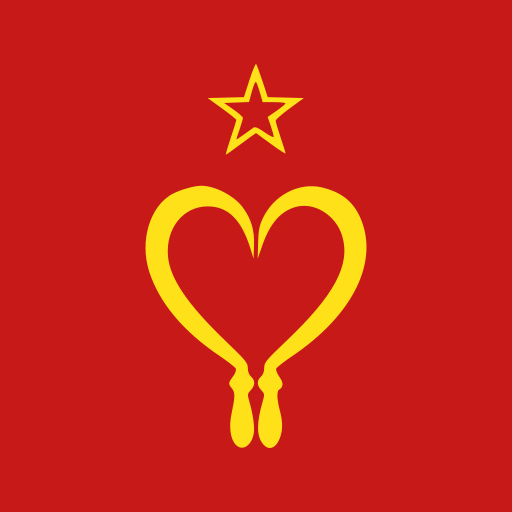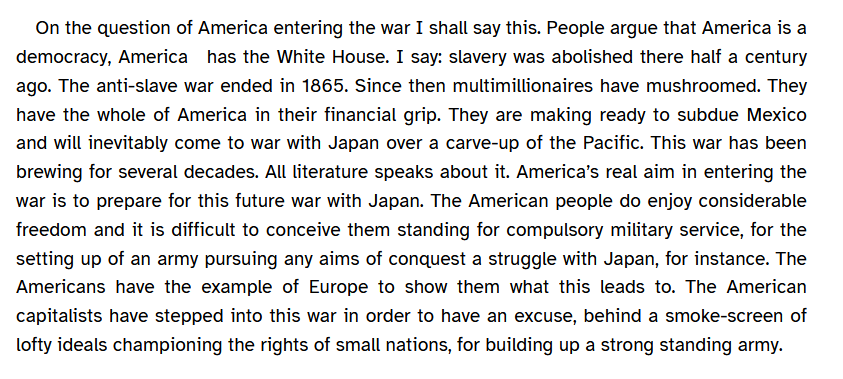Soviet Entropy
- 10 Posts
- 27 Comments

 133·2 days ago
133·2 days agoai art is art because people are mad about it.
jokes aside, i think that machine art is going to basically just replace clip art and the like. it’s like what happened to pottery. there are still artisinal potters (i love handmade pottery and the craft itself) but for everyday dinner plates you don’t seek the connection and craftsmanship. you just need a plate.
some art has use-value as decoration (easily replaced with machines) and other art is about personal, emotional, or political communication (even if it could be replaced, it wouldn’t be.)
it’s literally a broken chain.
Literally a broken chain.
You could make a movie called ‘The Folly of the Phallus’ where a man shoots himself in the foot everytime he feels emotions and people would idolize the main characters and complain that the message wasn’t clear enough.

 61·7 days ago
61·7 days agoThe evidence we have is that Swiss banks are likely key in how sanctions against Russia are being avoided.
https://www.bloomberg.com/news/articles/2022-09-20/swiss-imports-of-russian-gold-climb-to-highest-since-april-2020

 11·9 days ago
11·9 days agoi have a source now if you are genuinely curious.

 3·10 days ago
3·10 days agoah ok. my apologies :D

 37·10 days ago
37·10 days agois this a response to me?
i’m a bit confused.
i don’t know what the CPC have to do with the question of whether people on the internet should say they like Russia or Ukraine in a war.

 523·10 days ago
523·10 days agoyou shouldn’t.
there are many people who call themselves marxist-leninists on this site who do not subscribe to anything marx or lenin had to say about inter-imperialist conflict.
communists and marxists and leninists always seek peace above all else.
the only war worth fighting is class war and the inter-imperialist rivalry won’t benefit the working class.
https://www.marxists.org/archive/lenin/works/1916/feb/08.htmas a bonus, this speech is particularly prophetic. lenin calls calls out basically the next 100 years of US foreign policy in 1917.
https://www.marxists.org/archive/lenin/works/1917/may/14.htm

the only thing the people who call ourselves marxists leninists should be hoping for is a quick peace, a lasting peace, and a humiliating peace for both sides so that the army mutinies and makes proletarian seizure of state power possible (like happened in russia, angola, mozambique, etc.)
even tho virtue signalling is what most people here support, they have decided to support the russian government who made domestic abuse entirely legal and who criminalize queer identities freely expressing. condemning russia’s government is not endorsing ukraine’s.
EDIT: this entire site is filled with ultras, third-worldists, and campists whose beliefs amount to little more than “america bad” but framed in whatever quotations of leftist thinkers they need to justify themselves. read for yourself, think for yourself, and above all just get organized instead of treating politics like religious salvation and orthodoxy like so many people do.

 6·19 days ago
6·19 days agoi wanted to update.
they are a split from the IMT but it seems they aren’t 6 people reading books all day.
they also seem to have a very good grasp on how to communicate to radical but unorganized people which, even if you don’t like their politics, would be worth emulating.

 9·19 days ago
9·19 days agotheir website has a party program of clear goals which is more than most far left parties in the USA.

 2·22 days ago
2·22 days agoAh ok. I didn’t get that haha.
I hope you don’t get too much vitriol from the comments lol.

 2·22 days ago
2·22 days agoThis is a metaphysical question and can’t adequately be answered.
You can believe it if you want. There is nothing we can say to dissuade you.Materialists reject this view tho. We believe that the material world, made of particles, is all that exists.
But if believing we’re all in a dream makes you win power for the oppressed peoples of the world, then who am I to judge.

 3·24 days ago
3·24 days agoAnd don’t forget that even without money, we will still be able to measure embodied labor content. Even if the social arrangements don’t let embodied labor content be what determines distribution, it will still be measurable. Altho one would have to fix it relative to a specific year otherwise the growth in embodied labor will just be the size of the proletariat times the average hours worked.

 5·24 days ago
5·24 days agoI think you would very much enjoy the book “Classical Econophysics”!

 3·26 days ago
3·26 days agoYou bring up a good point. We can not assume the state will not act to repress us.
But I think you may be a bit too defeatist on this point (or maybe i’m misreading).The oppression of worker leadership is par for the course. As I mention, legalism is just a secular clergy and material reality is the more important factor. But to think the legal system does not matter is incorrect (and also not what you are arguing).
Gun control is also pretty much worthless in the United States. What little of it was passed in response to the Panthers was only after they did immense work and it was very inconsequential at large. The US has a huge stock of guns and most gun control laws that get passed (and indeed the entire debate around gun control) is over the flow of new guns.
While it is true that the Federal Government would fight any armed worker group, that does not mean that the legal framework is unimportant or not a point of difference. Imagine trying to form a worker militia in Canada or the UK where no such protections exist at all. Wins are made for the working class even within liberal democracies and bourgeois republics and rights are often protected. These are, afterall, exactly the thing fascism aims to remove.
I hope you don’t treat this as a polemic. Maybe I read your post in a doomer mindset because I’m often in one.
Thanks for the comment!

 12·26 days ago
12·26 days agoThat’s such a good way to put it!
Legalist traditions adapt to the wishes of the ruling class.
It’s like how in that one fallout game they couldn’t get the train working so they made the model a hat for an NPC walking around as the train.As a bonus bit of lore, Alabama (until 2022) had the largest constitution of any government on earth. The federal government mandated a not-entirely-racist state supreme court so to get around it the legislature would simply pass laws by having them be ammendments. It often has amendments that apply to single counties and there are specific local offices with salaries in the alabama state constitution. It was almolst 400,000 words with 977 ammendments.

 7·26 days ago
7·26 days agoSure! It’s a bit long but I hope I can answer all your questions.
There are 2 levels of elections in the US: local and state.
The states handle elections to federal offices like Congress and the President.There are two elections for each office: the primary elections and the election. The primary election is done usually in March and determines which candidates will be on the ballot for the offices up for election in November. This is basically the same across all states.
The primary elections are elections that technically happen only for the parties. To register as a member of a political party in the US you simply state that you want to when you register to vote. There is not special requirement.
Voting in the primaries is similar for basically every office at the local, state, and federal level. The only one where it is different is for President.
When you go to vote in the primaries you go to your local polling booth and they give you a ballot specific to the party that you are registered with. Some states let you pick which party’s ballot you want to vote with but not all. These states have “open primaries”.
Some offices like local judges are often not allowed to have party affiliation listed in many states. For these offices sometimes the candidates running are listed on both the Republican and Democrat ballots for the primary. So you sometimes get a situation where the same candidate wins the primary for the Republican Party and the Democratic Party so their name appears twice on the general election (but without any party listed next to them).
Normally though you go in to vote in the primaries and there are between 1 and 5 candidates (usually around 1 or 2) for each of the offices. Many parties only have one person running for an office and sometimes they don’t have anyone running at all. The winners of the primaries are the ones listed on the ballot for the actual election in November.
But how do you get listed on the ballot in the primaries?
The requirements are different in each state but they all work the same way. You go to the government offices of whatever county you live in (that’s the level between local and state) and they give you a petition form. You need to get enough signatures from people within your voting district of people registered in your party to get on the ballot. Once you get enough signatures, you go to the office again and they put you on the ballot.Some states have a requirement that for a party to have their candidate on the ballot in the regular election in November, they need to have enough people registered for that party.
When the election in November happens, the winners of each of the parties that had primary elections and who qualified to be on the ballot each appear with the party next to their name. The ballot is usually very long with some local, state, county, and federal offices all being elected at the same time. Oftentimes there will be only 1 option for an office as only 1 party nominated any candidates. Also for local offices or county offices there are sometimes no candidates listed. Almost every state lets you “write in” a candidate. You write the name of a person on a blank spot and fill in the little circle next to their name to vote for them.
Now the complicated bit: the president.
The political parties pick people who work or volunteer for them and have done a lot of work for them to be delegates.
They pick a number of delegates for each state but there is no reason for them to ensure a proportional number. They can pick whoever they want and however many people they want.Sometime during the summer, each of the parties holds a “national convention” where all the delegates get together and actually vote to nominate someone for president from their party. Before this, the delegates declare publicly who they would vote for if they were picked to go to the convention. So when the primary elections happen for president, the voters actually are picking a delegate, not the president. The way ballots looked in my state had the name of the delegate and then who they said they would vote for if they went to the convention. The delegate who gets the most votes goes to the convention.
So the convention happens and the delegates all cast their votes. But remember that they don’t have to vote for who they said they would. They are free to vote however they want. The parties also have something called “super delegates”. These are people who the party says have the same voting power as a delegate and so can vote however they want and are never elected. For the Democrats these are usually party donors, current state governors, the Clintons, etc.
In the actual election for president in November, the party nominees are listed on the ballot. But for president it is not an election but an opinion poll. Each state is given a set number of electors by the Constitution and the actual people are chosen by each state legislatue in different ways. Usually they are career politicians but their names are basically never known.
After the election in November, the votes from the people are totalled. Then in December the electors of each state meet in their state’s capital for a fancy dinner and they decide how they are going to vote. It is customary for all of the electors to cast their vote for whoever came in first in their state. But they do not have to. They each can vote for whoever they want (altho some states impose a fine of like $500 for doing this). The results of how the electors voted are then written down, certified, and send to Congress.
On January 6th, Congress meets and opens the results from each of the states and counts the votes of the electors. Back in the 1800s before the telegraph this would actually be when people found out who the president was, but nowadays we know on election night in November because each political party has someone at each polling place asking the volunteers counting the votes what the results are. They then text the next person higher up and then they text and then the results are known almost immediately.

 16·26 days ago
16·26 days agoThe main lesson here is that no matter what the religious texts (the laws) say, if the ruling class want a material outcome (like armed men with military training always at the ready) they can often get it. Do not be fooled by legal fictions but also do not underestimate the power of having the secular clergy justify your actions can be on the masses. All is a tool.
There isn’t really a reason to do an “either or” here but a “yes and”.
Both have happened in every successful socailist revolution.
I think that for many regular people, “tax the rich” is not as tainted with anti-communist propaganda as “seize the means of production”. Taxing the rich does weaken them. Revolutions aren’t built in a day comrades.



Guy who argues mumble rap is stupid because you can’t even understand what they’re saying while listening to Jack Stauber on spotify.